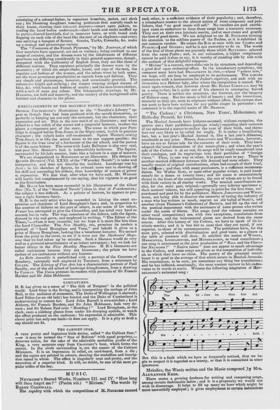EMBELLISHMENTS OF THE MONTHLY NOVELS AND MAGAZINES.
GEORGE CROIKSHANE'S illustrations to the "Novelist's Library" ap- pear as though they had been produced with the novels themselves, so
perfectly in keeping are not only the costumes, but the characters, their expression and air. This is the rare merit of an illustrator ; and when joined to a fine relish of the scenes and a congenial humour, renders the plates a component part of the story. The scene in which poor Part- ridge is dragged before Tom Jones, in the Gipsy-court, is rich in genuine
• character ; the culprit looks self-condemned. Squire Western seizing Tom Jones, is as like the actual scene as we can suppose possible : the Squire is the beau ideal of a fox-hunter of the old school, and the parson is of the same kidney. The scene with Lady Bellaston is also very real, and poor Mrs. Honour's look is indescribably ludicrous. The Squire, surrounded by his lady cousins, looks like a baboon in a cage of macaws.
We are disappointed in BONINGTON as an illustrator. His designs for Quentin Durward (Vol. XXXI. of the "Waverley Novels") is tame and inexpressive, and does not describe the incident. Landscape was his _forte : in his sketches of figures, he evinced more tact in showing off his skill and concealing his defects, than knowledge of nature or power 4ca expression. We fear that, after what we have said, Mr. WRIGHT will hardly feel complimented by our saying, that his vignette is as good as the frontispiece.
Mr. HOLST has been more successful in his illustration of the Ghost • Seer (No. X. of the "Standard Novels") than in that of Frankenstein; the subject is less difficult. As a painter of horrors, he appears to pos- sess a right German fancy. H. B. is the only artist who has succeeded in hitting the exact ex- pression and character of Lord Brougham's face ; and, in proportion to the number of failures on the part of others, is our sense of his talent. Fraser has attempted to give the Chancellor, and has tried very hard to succeed, but in vain. The wag, conscious of the failure, calls the figure, dressed in wig and gown, and employed in writing, " The Editor of the Times,"—whom it may resemble, but we hope it is more like him than the Lord Chancellor. The New Monthly, too, promises its readers a portrait of " Lord Brougham and Vaux," and behold it gives us a print of Henry Brougham, looking like a beneficent lecturer. We turned from the print to the cover, to see if it were not the Mechanics' Maga. zine that we had taken up by mistake. Such a likeness would do very well as a pictorial advertisement of an infant newspaper ; but we look for better things in the New Monthly Magazine. H. B.'s likenesses are called caricatures because they are humorous ; the prints we have spoken of are caricatures without any humour. La Belle Assemblge is embellished with a portrait of the Countess of Rosebery, extremely well engraved by Tnousors, from a miniature by COLLEN. The Library of Fine Arts has a characteristic portrait of Paul Sandby, one of the old school of landscape draughtsmen, from a drawing by COSWAY. The Union presents its readers with portraits of Sir Francis Burdett and Sir John Hobhouse.


























 Previous page
Previous page